Japanese ginger sauce is a delicious, savory sauce perfect for dipping and marinating all kinds of meat. It’s a popular sauce to find at your favorite hibachi restaurant and easy to recreate and enjoy at home!
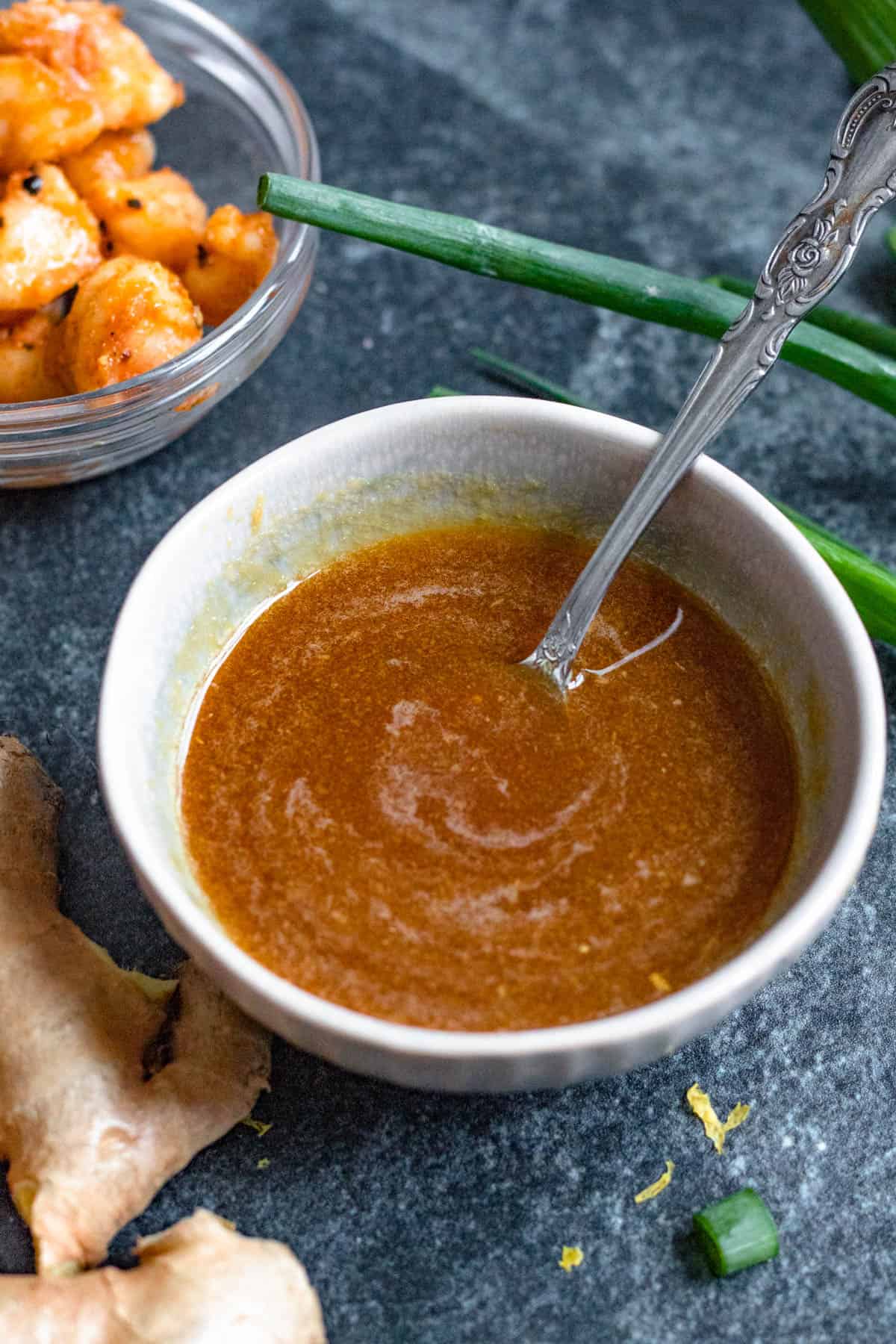
Hello Reader! I try my hardest to research recipes as best as I can before posting to ensure I am representing each culture correctly. If this recipe is from your country and I have made a mistake or you have suggestions for how to make it more authentic, I would love to hear! Please leave a comment below letting me know what should be different, and I will rework the recipe. It is always my intention to pay homage and respect to each cultural dish that I cook. Thanks for reading!
Japanese hibachi is known for tender meat cooked right in front of you, but the real star of the show is the amazing sauces served alongside the meat (including my FAVORITE, Yum Yum Sauce!).
Authentic Japanese hibachi is made with high-quality meat that is only lightly seasoned, allowing dipping sauces to provide the main source of flavor. This particular sauce provides a flavor that is not easily forgotten!
Japanese Ginger sauce recipe is bold, tangy, and just slightly sweet. The combination of onions, ginger, lemon, and brown sugar pairs perfectly with hibachi steak, hibachi shrimp, or just about any meat.
This Japanese Ginger sauce Recipe is not difficult to make at home. All you need is a blender or a food processor to mix and chop the ingredients to your preference. You can use the sauce for hibachi and save any leftovers to use as a marinade, to add a unique flavor to your favorite fried rice dish, gyoza, or egg rolls, or even to use as a salad dressing with a little added sesame oil.
Once you’ve tried it, it’s a sauce you are sure to keep coming back to again and again!
Recipe Origin
Hibachi is a style of Japanese barbeque that has been around for centuries, but the first official Japanese steakhouse restaurant was not opened until the 1940’s. When hibachi made its way to the United States around the 1960’s it took off very quickly.
Japanese hibachi has always been a great way to gather with friends and enjoy a fun environment along with great food.
Japanese barbeque differs from Korean barbeque because rather than being marinated for a long period of time, the meat is left unseasoned. The flavor is added to the meat after it is cooked when it is dipped in a variety of flavorful sauces like Yum Yum sauce, soy sauce, and more.
Benihana is the most popular brand of hibachi restaurants in the United States and their most-requested sauce is this hibachi ginger sauce.
Why Make This Recipe
- Simple Ingredients: There’s a good chance you have most of these ingredients on hand at home. It’s easy to throw them all together in a food processor and create a Japanese ginger dressing that is unique and full of fresh flavor.
- Amazing Flavor: There is nothing quite like the taste of fresh ginger in Asian cuisine. This delicious Japanese sauce brings the perfect spike of ginger flavor to any meat and can also be used over rice, noodles, side salad, or vegetables.
- Restaurant Flavor at Home: This dipping sauce is truly the star of the show at any hibachi restaurant and for good reason. If you are hoping to bring some restaurant quality to your next lunch or dinner this easy recipe makes it possible!
What Do You Need To Make This Recipe
Ingredients
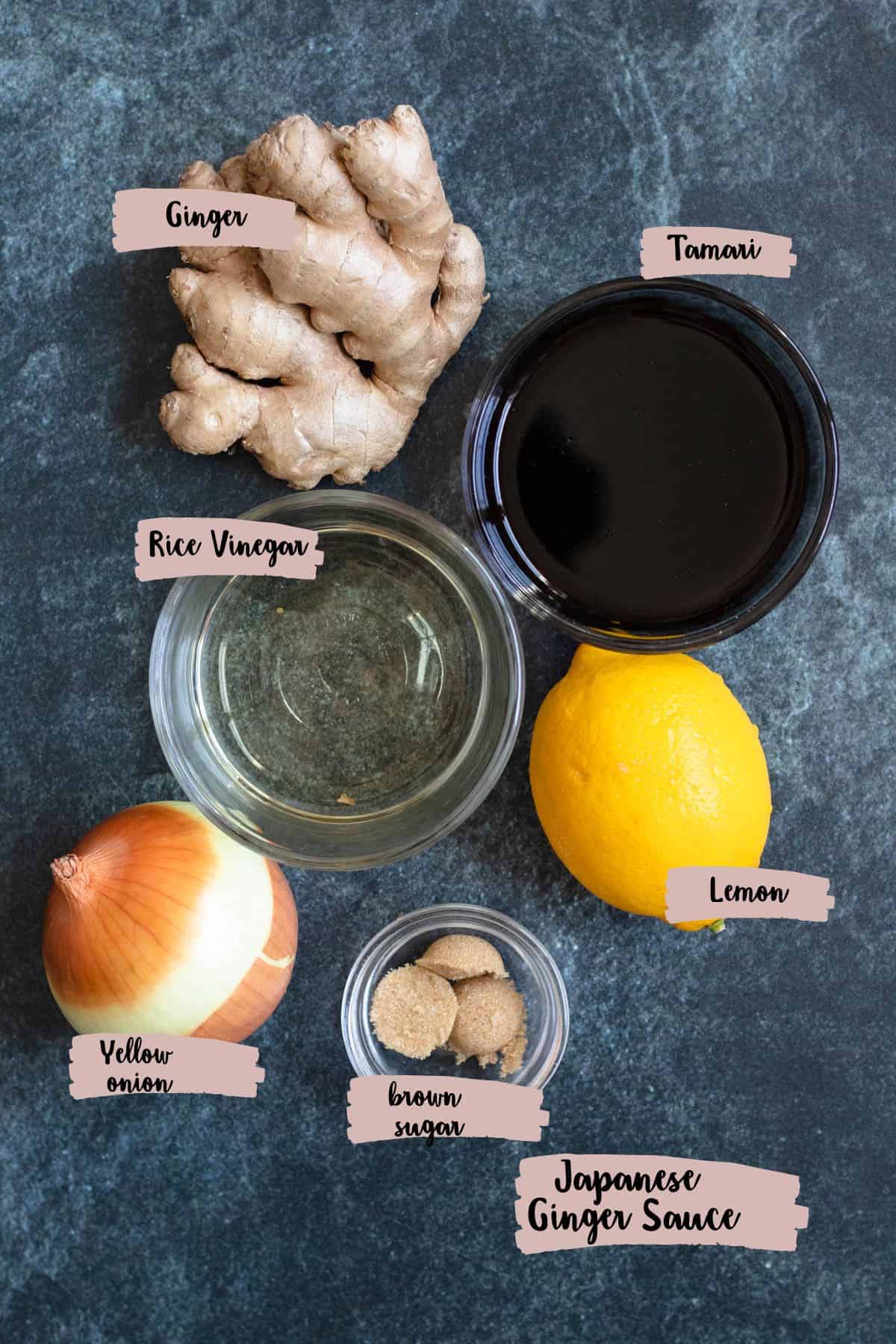
Here is a visual overview of the ingredients in the recipe. Scroll down to the recipe at the bottom for quantities.
- Yellow Onion: Yellow onion is popular in Japanese recipes. It’s not quite as strong as white onion and red onions, and not as mild as sweet onion. You can use any onion you have on hand, but a simple yellow onion is just right for this sauce.
- Fresh Ginger Root: If you have never used fresh ginger before, use a spoon to scrape away the brown skin from the exterior, then slice. You could also use pre-packaged minced ginger from the produce section of your local grocery store. You can usually find it refrigerated next to the minced garlic.
- Tamari: Tamari is made from fermented soybeans and is considered the darkest kind of soy sauce. It adds a delicious, salty umami flavor to the sauce. You could substitute normal or dark soy sauce or coconut aminos if needed. Tamari is gluten-free and is a great substitute for soy sauce for anyone with gluten intolerance.
- Fresh Lemon Juice and Zest
- Brown Sugar: You can substitute with white sugar in a pinch
- Rice Vinegar: You could substitute apple cider vinegar, malt vinegar, rice wine vinegar, or plain white vinegar
Tools
- Food Processor or Blender
How to Cook With Fresh Ginger
Fresh ginger is a great ingredient to keep in your kitchen, especially if you enjoy Asian cuisine. Many people are intimidated by the brown skin and knobby look of ginger, but it is very easy to use and adds excellent flavor to salad dressings and sauces.
When purchasing fresh ginger, look for plants that are thick and moist. You don’t want to choose one that is shriveled or looks dried out. Ginger is in season in the spring, but you can find it year-round in most grocery stores next to garlic or scallions.
If you are blending the ginger you don’t necessarily have to peel it, but it is a good idea if you desire a smoother texture for your sauce. A spoon is the best method for peeling ginger because it takes off just a little bit of ginger skin while leaving the flesh behind. You could also peel ginger with a vegetable peeler but you should use caution. Your piece of ginger may be small and difficult to hold without getting cut.
You can leave any leftover ginger on the counter or wrap it in a paper towel and some plastic and store it in the refrigerator. Ginger also freezes well.
How to Make This Recipe
Step One: Blend
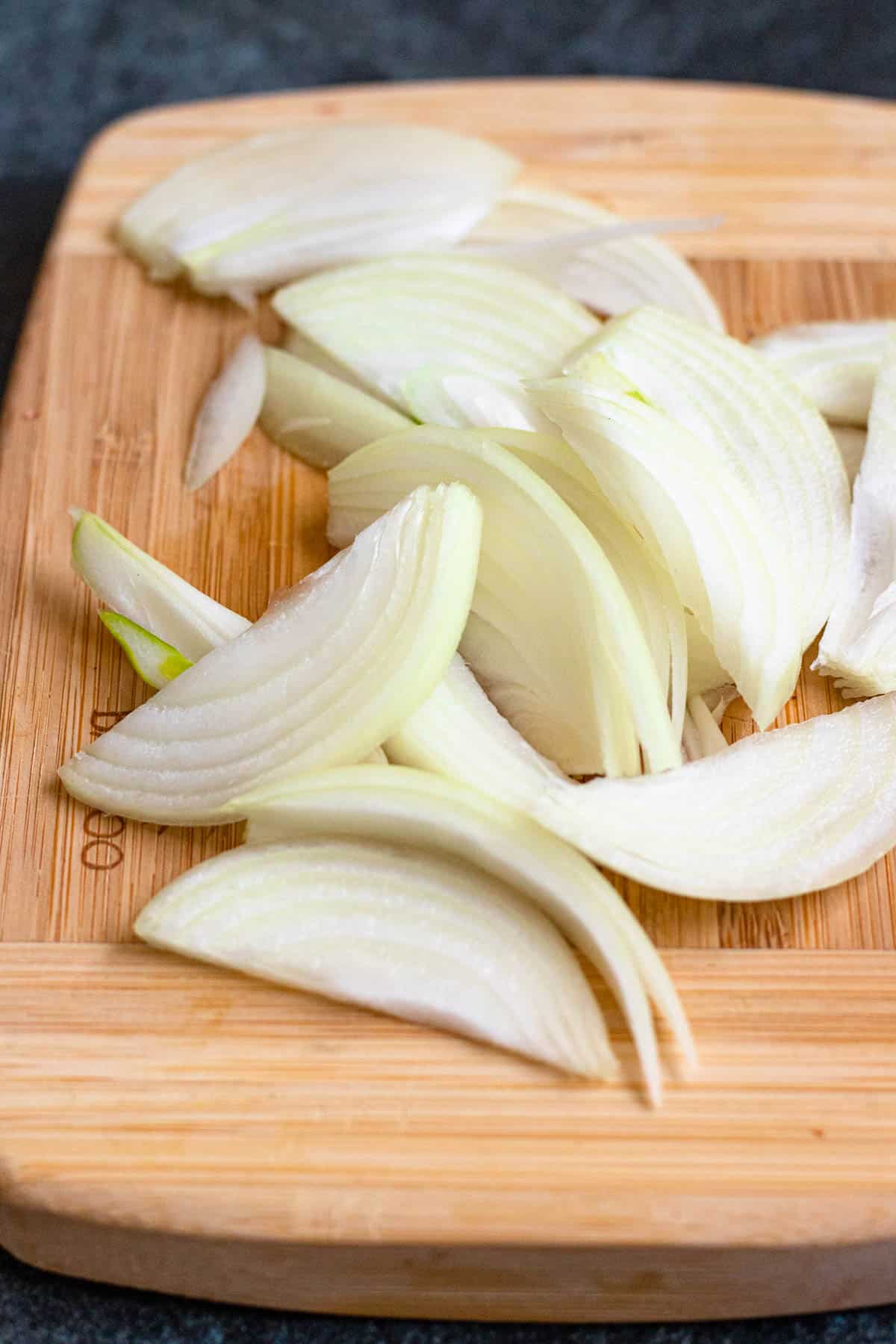
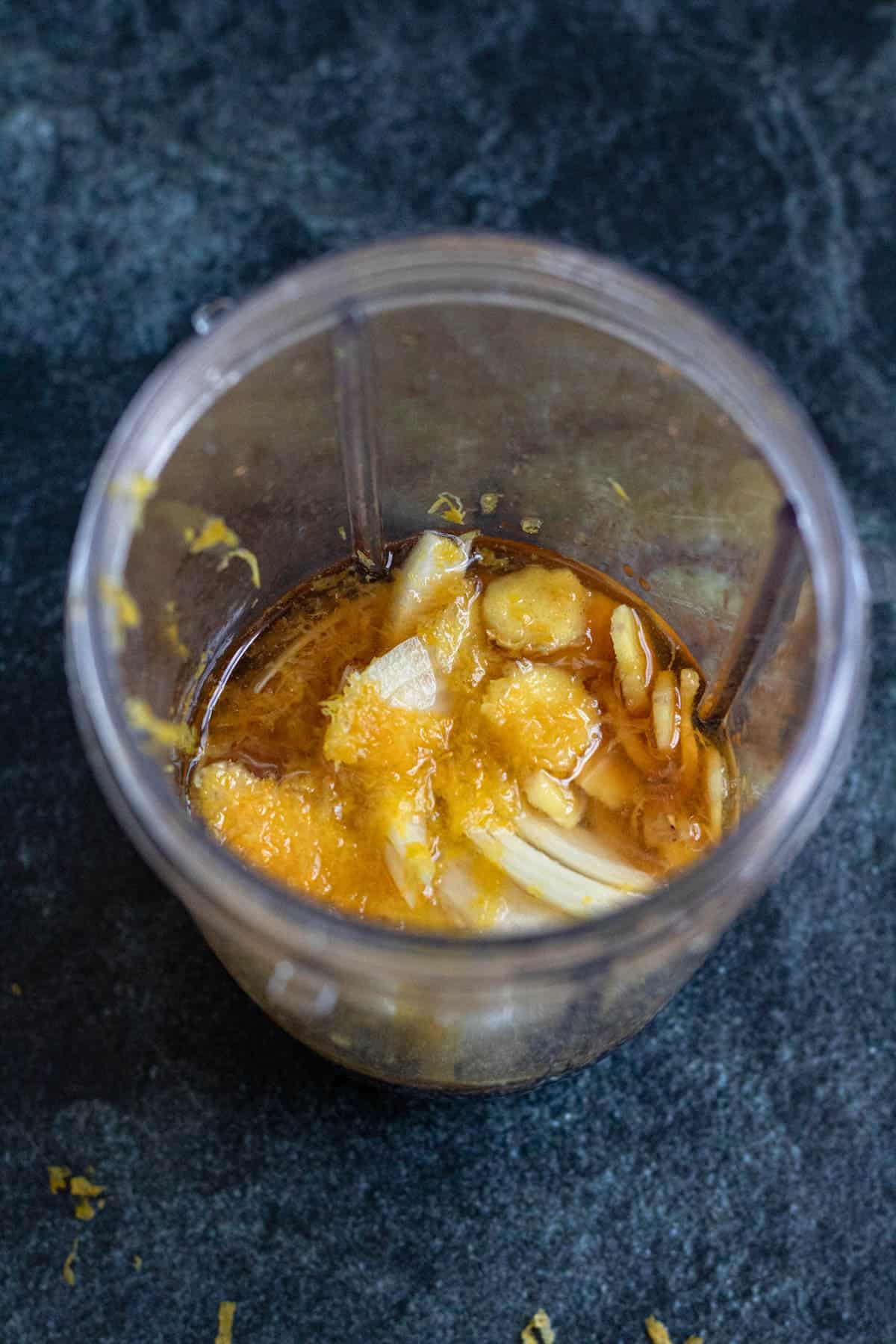
Gather the ingredients. Blend them together in a small food processor or blender until everything is smooth. Pour into a small bowl for dipping. Serve and enjoy!
Expert Tips

- The flavor of this sauce improves if it has some time to sit. For the best results, blend it up and leave it to settle in the refrigerator overnight before serving.
- If you prefer a chunkier ginger sauce, you can lightly blend to achieve that consistency.
- After blending, you may need to skim the foam off of the top of the ginger sauce to see the nice brown color underneath.
- If you are hoping to save time, you can use the minced ginger found in the produce section at the grocery store.
- Feel free to adjust the amount of each ingredient to achieve the right flavor. The sweetness of different onions and different brands of soy sauce may impact the flavor of this Japanese Ginger Sauce Recipe.
FAQ
Yes, store this in an airtight container in the refrigerator for up to five days.
This sauce will also freeze well. You could make a large batch and save any leftovers in the freezer for later. It should stay well in the freezer for several months. Thaw it in the refrigerator or at room temperature to use.
This amazing sauce can be used in so many delicious ways. Use it as a marinade on just about any meat, seafood dishes, or even tofu or cauliflower. You can also sprinkle it over fried rice or use it as a salad dressing.
If you use it as a salad dressing on a simple green salad, you may want to add some oil or use low-sodium soy sauce because the flavor of the fresh ingredients can be quite strong.
You could use ground ginger instead of fresh ginger but if you choose to do so, use caution. Ground ginger is more potent than fresh ginger so you will probably want to adjust how much you use. Start out small and add more to taste.
If you are nervous about using fresh ginger, I recommend using the pre-package minced ginger. Ground ginger will work, but fresh ginger will work best.
As mentioned earlier, most hibachi meat is not heavily seasoned before it is cooked. It may be squirted with soy sauce or sesame oil to keep it from drying out while cooking.
The exact sauces served with a hibachi meal may vary depending on the restaurant or even the chef. Typically you’ll find soy sauce on the table but you may also see teriyaki sauce, sweet and sour sauce, ginger sauce, and even spicy sauces like sriracha. In American hibachi restaurants, you will also see Yum Yum Sauce. The sauces can be used to add flavor to the meat, plain rice, or hibachi vegetables.
Did you enjoy this Japanese Ginger Sauce Recipe? If so, make sure to check out these other recipes I picked out just for you:
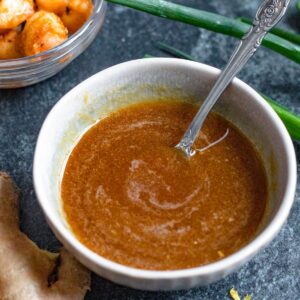
Japanese Ginger Sauce Recipe
Equipment
- Food Processor/Blender
Ingredients
- ½ small Yellow Onion, sliced
- 1 inch Fresh ginger root, sliced
- ½ cup Tamari
- ½ Lemon, Zested and juiced
- 1½ tsp Brown Sugar
- ¼ cup Rice Vinegar
Instructions
- Gather the ingredients. Blend them together in a small food processor or blender until everything is smooth. Serve and enjoy!
Notes
- Fresh Ginger Root: If you have never used fresh ginger before, use a spoon to scrape away the brown skin from the exterior, then slice. You could also use pre-packaged minced ginger from the produce section of your local grocery store. You can usually find it refrigerated next to the minced garlic.
- Tamari: Tamari is made from fermented soybeans and is considered the darkest kind of soy sauce. It adds a delicious, salty umami flavor to the sauce. You could substitute normal or dark soy sauce or coconut aminos if needed. Tamari is gluten-free and is a great substitute for soy sauce for anyone with gluten intolerance.
- Fresh Lemon Juice and Zest
- Brown Sugar: You can substitute with white sugar in a pinch
- Rice Vinegar: You could substitute apple cider vinegar, malt vinegar, rice wine vinegar, or plain white vinegar
- The flavor of this sauce improves if it has some time to sit. For the best results, blend it up and leave it to settle in the refrigerator overnight before serving.
- If you prefer a chunkier ginger sauce, you can lightly blend to achieve that consistency.
- After blending, you may need to skim the foam off of the top of the ginger sauce to see the nice brown color underneath.
- If you are hoping to save time, you can use the minced ginger found in the produce section at the grocery store.
- Feel free to adjust the amount of each ingredient to achieve the right flavor. The sweetness of different onions and different brands of soy sauce may impact the flavor.




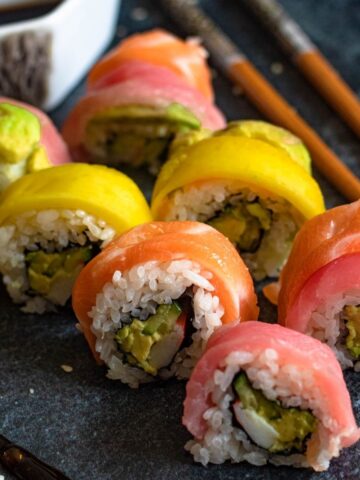
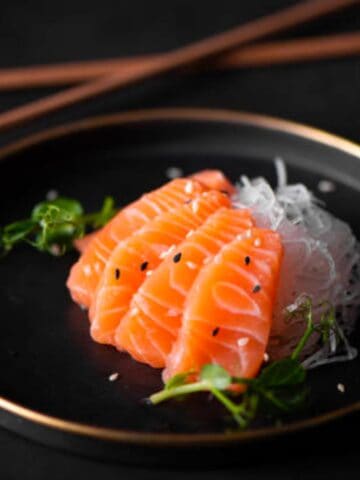
Leave a Reply